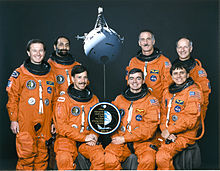STS-75

Columbia launches on STS-75
|
|
| Mission type | Microgravity research Technology development |
|---|---|
| Operator | NASA |
| COSPAR ID | 1996-012A |
| SATCAT no. | 23801 |
| Mission duration | 15 days, 17 hours, 40 minutes, 22 seconds |
| Distance travelled | 10,500,000 kilometres (6,500,000 mi) |
| Orbits completed | 252 |
| Spacecraft properties | |
| Spacecraft | Space Shuttle Columbia |
| Payload mass | 10,592 kilograms (23,351 lb) |
| Crew | |
| Crew size | 7 |
| Members |
Andrew M. Allen Scott J. Horowitz Jeffrey A. Hoffman Maurizio Cheli Claude Nicollier Franklin R. Chang-Diaz Umberto Guidoni |
| Start of mission | |
| Launch date | 22 February 1996, 20:18:00 UTC |
| Launch site | Kennedy LC-39B |
| End of mission | |
| Landing date | 9 March 1996, 13:58:22 UTC |
| Landing site | Kennedy SLF Runway 33 |
| Orbital parameters | |
| Reference system | Geocentric |
| Regime | Low Earth |
| Perigee | 277 kilometres (172 mi) |
| Apogee | 320 kilometres (200 mi) |
| Inclination | 28.45 degrees |
| Period | 90.5 minutes |
 Left to right - Seated: Horowitz, Allen, Chang-Diaz; Standing, Cheli, Guidoni, Hoffman, Nicollier |
|
STS-75 was a United States Space Shuttle mission, the 19th mission of the Columbia orbiter.
The primary objective of STS-75 was to carry the Tethered Satellite System Reflight (TSS-1R) into orbit and to deploy it spaceward on a conducting tether. The mission also flew the United States Microgravity Payload (USMP-3) designed to investigate materials science and condensed matter physics.
The TSS-1R mission was a reflight of TSS-1 which was flown onboard Space Shuttle Atlantis on STS-46 in July/August 1992. The Tether Satellite System circled the Earth at an altitude of 296 kilometers, placing the tether system within the rarefied electrically charged layer of the atmosphere known as the ionosphere.
STS-75 mission scientists hoped to deploy the tether to a distance of 20.7 kilometers (12.9 mi). Over 19 kilometers of the tether were deployed before the tether broke. It remained in orbit for a number of weeks and was easily visible from the ground, appearing something like a small but surprisingly bright fluorescent light traveling through the sky.
The electric conductor of the tether was a copper braid wound around a nylon (Nomex) string. It was encased in teflon-like insulation, with an outer cover of kevlar, inside a nylon (Nomex) sheath. The culprit turned out to be the innermost core, made of a porous material which, during its manufacture, trapped many bubbles of air, at atmospheric pressure.
Later vacuum-chamber experiments suggested that the unwinding of the reel uncovered pinholes in the insulation. That in itself would not have caused a major problem, because the ionosphere around the tether, under normal circumstance, was too rarefied to divert much of the current. However, the air trapped in the insulation changed that. As it bubbled out of the pinholes, the high voltage of the nearby tether, about 3500 volts, converted it into a plasma (in a way similar to the ignition of a fluorescent tube), a relatively dense one and therefore a much better conductor of electricity. This plasma diverted to the metal of the shuttle and from there to the ionospheric return circuit. That current was enough to melt the cable.
...
Wikipedia

